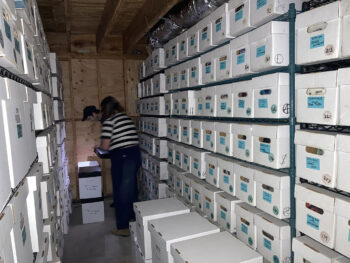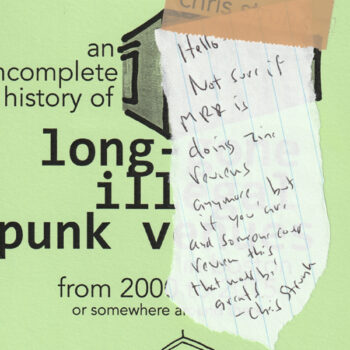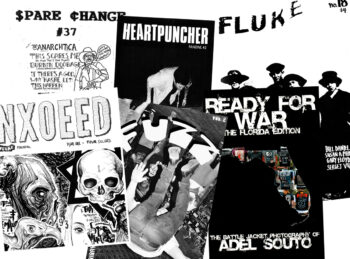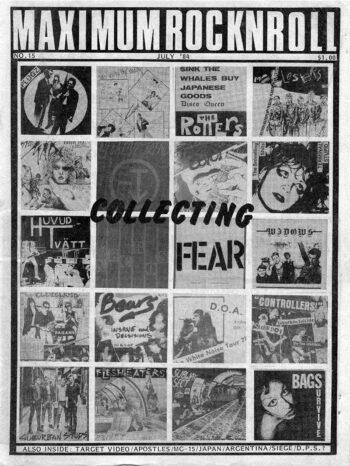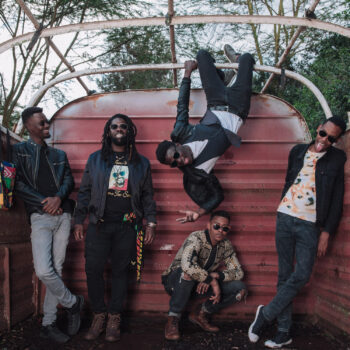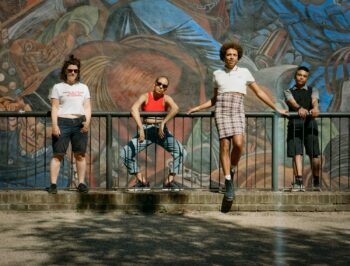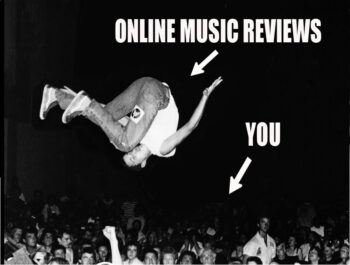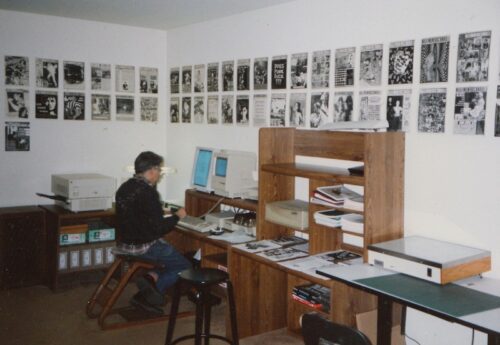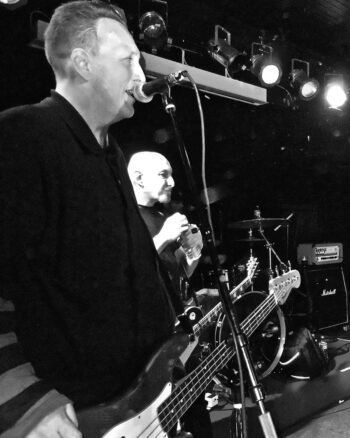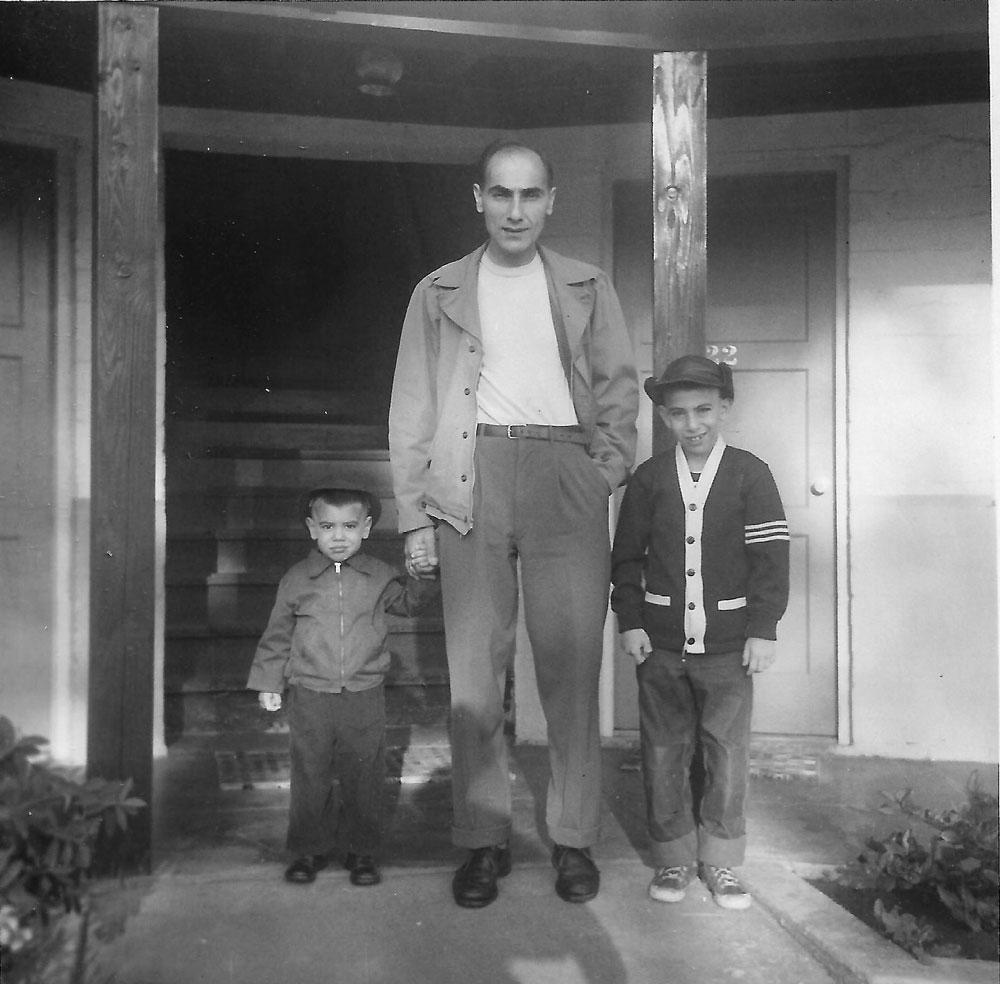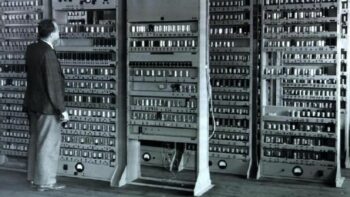Una Parte: Documentary of the punk scene in TucumÁ¡n, Argentina
With the the help and hard work of Mariel Acosta, one of the translators that helps out MRR, we bring you this synopsis in both English y espaÁ±ol of this documentary that I came across a few months ago. Even if you don’t speak Spanish, use Mariel’s great article here, and the music and cool footage in the documentary to guide you! It is worth it! Thanks to Mariel, Jose Young Man and Josi Punk for all their help!

“Through this humbly produced documentary, which consists of interviews, TV show archival footage, and material donated by the protagonists, we try to bring to light the cultural, political and social values of punk, hardcore, and of the people that were involved in building a DIY movement that’s independent of any state institution.”
—José Saravia
The documentary, Una Parte was created by Jose Saravia with the collaboration of Benjamin Herrera and Fito Pereira. It is an extensive compilation of interviews, testimonies, and stories of punks from the province of San Miguel de TucumÁ¡n, located northwest of Argentina. In the documentary, Saravia presents a great variety of pictures and footage from shows, and images of zine covers from TucumÁ¡n and the rest of Argentina. This “mega proto-documentary” is divided in 4 chapters. The first chapter talks about the punk movement in TucumÁ¡n in the ’80s, the second and third ones discuss the movement in the ’90s, and the fourth one focuses on the fanzine movement.
The punk movement in TucumÁ¡n emerged in the midst of the transition from a dictatorial military regime that lasted from 1976-1983 to democracy. These social and political changes marked the younger population that emerged out of that dark era with the hopes of manifest their ideas and express themselves freely. Tucuman punk, as a musical, sociocultural and political movement emerged as that, longed for, means for expression among the youth with “punk” and “rebellious” attitude, overcoming prejudices, stereotypes, and social stigmatization from mainstream society. “In rock music I found a space to say things,” tells Coqi Mendez, lead singer of the rock band Euzkadi formed in 1991, referring to having found in music a way to express herself. Euzkadi’s shows were characterized by the rawness and artistic creativity, and their music by the mix of different music genres such as, psychedelic, punk, rock, bolero and jazz.
Furthermore, Lobo, from the fanzine Revista Basta, refers to Argentinean punk as a “kultural” movement that was spread out through radio shows, magazines, fanzines, and shows and is was formed by people that didn’t “fit” into the rest of society.
Shows and “festipunks” or punk fests maintained unity in the Tucumanean scene. Bands organized shows anywhere they could: houses, garages, stores, sports fields, among other venues. In the ’80s, shows were usually attended by dozens of punk kids; by the ’90s the assistance of punks to shows ascended to the hundreds, and even thousands in fests. On a small level, the development of the punk movement in TucumÁ¡n was helped by friends spreading the word about bands and gigs among their peers, exchanging cassettes and records, jamming and playing music. Punk movement stayed active because “punkies” could “share with people like us”; that is, likeminded kids getting together to listen to punk and make music, which is what identified them as a group.
(See below for the links to continue watching the full film.)
Chapter 1 of the documentary is about the hard rock and punk movements in 1980s TucumÁ¡n; described through the accounts from the protagonists of the scene in that time (band members, radio show hosts and fanzine editors). They talk about the places where they used to hang out, the difficulties the scene had to face, and the contradictions of the so-called democracy after the dictatorship. The difficulty to access instruments and equipment, records and music; also, mainstream society’s prejudices, and the ongoing police repression are among the topics discussed by the interviewees.
Chapters 2 and 3 try to reconstruct the emerging punk and hardcore in TucumÁ¡n in the ’90s. Some of the interviewees talk about the beginnings of their bands, fanzines, and radio shows in a time were the metal scene was most predominant. Moreover, important bands like Volstead, Eructo, Los Chiclets, and Sol Perpetuo are mentioned. One of the most important topics discussed in the second chapter is the introduction to the movement of issues such as animal rights, vegetarianism, and encouragement of female participation in the scene by the band Fun People from the Buenos Aires scene; the first one to come from another city. In chapter 3, female musical involvement in the scene is discussed more in depth; as well as the fanzine movement in TucumÁ¡n.
Chapter 4 is about the creation and distribution of fanzines in TucumÁ¡n and other cities in Argentina. Along with the punk movement, the concept of creating zines in Argentina develops in the early ’80s. In spite of the scarce resources Tucuman punks had, in the ’90s the fanzine movement gained momentum. Fanzines were distributed throughout the country and the world; this created a worldwide net through the mail. Publications were exchanged from the scene of one country to the other, ideas were spread, and friendship and cooperation bonds developed.
 Una Parte: Documental de la escena punk en TucumÁ¡n, Argentina.
Una Parte: Documental de la escena punk en TucumÁ¡n, Argentina.
“A través de este precario documental realizado a través de entrevistas, archivos de un programa de televisiÁ³n y material aportado por los y las protagonistas se trata de remarcar el valor cultural, polÁtico y social del punk, del hardcore y de las personas que estuvieron involucradas en construir un movimiento de manera autogestionada y al margen de todo organismo estatal.”
—José Saravia.
El documental Una Parte fue realizado por José Saravia con la colaboraciÁ³n de BenjamÁn Herrera y Fito Pereira. Es una extensa compilaciÁ³n de entrevistas, testimonios e historias de integrantes de las bandas de punk que han existido en la provincia de San Miguel de TucumÁ¡n, localizada al noroeste de Argentina. En el documental, Saravia presenta una gran variedad de fotos y grabaciones de conciertos, e imÁ¡genes de zines de TucumÁ¡n y toda Argentina.
Este “mega proto-documental” estÁ¡ dividido en cuatro capÁtulos: el primero que habla del movimiento punk en TucumÁ¡n en los aÁ±os ’80, el segundo y tercero que hablan de la escena en los aÁ±os ’90 y el cuarto que se enfoca en los fanzines. El movimiento punk en TucumÁ¡n surgiÁ³ en medio de la transiciÁ³n de la dictadura militar que gobernÁ³ a Argentina de 1976-1983 a la democracia. Estos cambios polÁticos y sociales marcaron a la juventud que emergÁa de esa época oscura con nuevas esperanzas para manifestar sus ideas y expresarse libremente. El punk, como movimiento musical, sociocultural y polÁtico surge como ese anhelado medio de expresiÁ³n de los jÁ³venes de actitud “punk” y “rebelde,” sobrepasando prejuicios, estereotipos y el estigma de la sociedad general. “Encontré en el rock un espacio para decir,” relata Coqi Mendez, cantante de la banda Euzkadi formada en 1991; refiriéndose, que hacer mÁºsica para ella como cantante era una forma de expresiÁ³n. Los conciertos de Euzkadi se caracterizaban por su crudeza, y creatividad artÁstica y su mÁºsica por la mezcla de otros géneros como psychodelic, punk, rock, bolero y jazz.
Por otro lado, Lobo, del fanzine Revista Basta, refiriéndose al punk en Argentina dice que es una movida “kultural” que se difundÁa por medios como radio, revistas, fanzines, y recitales o conciertos, y estaba formada por personas que no “entraban” en el resto de la sociedad.
Los conciertos y los “festipunks” ayudaban a mantener la escena tucumana unida. Las bandas organizaban conciertos en cualquier lugar: casas, garajes, locales comerciales, canchas deportivas, entre otros. En los aÁ±os ’80, el pÁºblico constaba de decenas de jÁ³venes, ya para los noventa eran cientos y hasta miles los que asistÁan a festivales. En menor escala, algo que también ayudo al desarrollo del movimiento fue el sentimiento en comÁºn que compartÁan los jÁ³venes hacia la mÁºsica punk. Los punks se reunÁan a tocar, intercambiaban casetes y discos, y difundÁan la voz, sobre movimiento, entre sus amigos. El movimiento se mantuvo activo por el hecho de que los “punkys” podÁan “compartir con personas que son como uno.”
El capitulo 1 cuenta de “las movidas” o los movimientos hard rock y punk en TucumÁ¡n en los aÁ±os ’80 a través de relatos de sus protagonistas (integrantes de bandas, programas de radio y editores de fanzines). Estos comentan sobre los lugares que frecuentaban, las dificultades a las que se enfrentaban y las contradicciones que presentaba la tan esperada democracia luego del fin de la dictadura . El difÁcil acceso a instrumentos, discos, videos y equipos, los prejuicios de la sociedad, el estigma del miedo y la continuaciÁ³n de las prÁ¡cticas represivas son algunos de los temas a que se refieren los entrevistados.
En los capÁtulos 2 y 3, tratan de reconstruir lo que fue la incipiente movida punk y hardcore en TucumÁ¡n a mediados de los ’90. Algunos de sus protagonistas nos comentan como comenzaron con sus bandas, fanzines y programas de radio en una época donde el movimiento era mÁ¡s bien metalero. AdemÁ¡s, se hace menciÁ³n de las bandas que tuvieron un poco mÁ¡s de trascendencia como Volstead, Eructo, Los Chiclets y Sol Perpetuo. Unos de los temas resaltantes del capÁtulo 2 es la introducciÁ³n al movimiento (por parte de la banda Fun People de Buenos Aires) de temas como los derechos de los animales y vegetarianismo e incentivaba la participaciÁ³n femenina en la escena. En el capÁtulo 3 también se discute mÁ¡s a fondo la participaciÁ³n femenina en el aspecto musical del movimiento y se introduce el tema del movimiento fanzinero en TucumÁ¡n.
El capÁtulo 4 trata de la creaciÁ³n y distribuciÁ³n de los fanzines en TucumÁ¡n y otras ciudades de Argentina. Junto con el movimiento punk, la idea de los fanzines llega a Argentina a principio de los ’80. A pesar de la precariedad econÁ³mica con que se manufacturaban los fanzines en los ’90, el movimiento fanzinero alcanza gran masividad. Se empiezan a editar y distribuir fanzines a lo largo de todo el paÁs y del mundo, creÁ¡ndose una extensa red conectada por el correo postal, a través del cual se intercambiaban las publicaciones, se difundÁan ideas y se creaban lazos de amistad y cooperaciÁ³n.
Find the videos here!
Chapter/CapÁtulo 1 (in three parts): vimeo.com/31139997
Chapter/CapÁtulo 2 (in full): www.unaparte.com.ar
Chapter/CapÁtulo 3 (part 1): www.youtube.com/watch?v=0iZYyhuGTYU
Chapter/CapÁtulo 3 (part 2): www.youtube.com/watch?v=_khI74jQM14
Chapter/CapÁtulo 4 (in three parts): www.youtu.be/KMbI6KbYuY8

